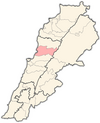Ashqout
عشقوت | |
|---|---|
Municipality | |
| Coordinates: 33°59′14″N 35°42′27″E / 33.987353°N 35.707626°E | |
| Country | Lebanon |
| Governorate | Keserwan-Jbeil |
| District | Keserwan |
| Area | |
| • Total | 7.88 km2 (3.04 sq mi) |
| Elevation | 1,250 m (4,100 ft) |
| Time zone | UTC+2 (EET) |
| • Summer (DST) | UTC+3 (EEST) |
| Dialing code | +961 |
Ashqout (Arabic: عشقوت; also spelled Ashkout, Achqout, `Ashqut) is a town and municipality in the Keserwan District of the Keserwan-Jbeil Governorate of Lebanon. It is located 31 kilometers north of Beirut. Ashqout's average elevation is 1,000 meters above sea level and its total land area is 588 hectares.[1] Its inhabitants are predominantly Maronite Catholic, with Christians from other denominations in the minority.[2]
Ottoman tax records indicate Ashqout had 43 Christian households in 1523, 43 Christian households and seven bachelors in 1530, and 33 Christian households and 14 bachelors in 1543.[3]
The town has three schools, one public and two private, in the town, with a total of 739 students as of 2008.[1] The El-Hajj Hospital, which has 28 beds, is located in Ashqout.[1] It is the birthplace of Ahmad Faris Shidyaq (1804–1887); Paul Peter Massad (1806–1890); and Rayyane Tabet (born 1983).[4]
References
[edit]- ^ a b c "Aachqout". Localiban. Localiban. 2008-01-18. Retrieved 2009-07-24.
- ^ "Elections municipales et ikhtiariah au Mont-Liban" (PDF). Localiban. Localiban. 2010. p. 19. Archived from the original (pdf) on 2015-07-24. Retrieved 2016-02-12.
- ^ Bakhit 1972, p. 275.
- ^ "Rayyane Tabet's first US museum commission opens at the Walker". Artdaily.com. June 12, 2021. Retrieved 2022-04-02.
Bibliography
[edit]- Bakhit, Muhammad Adnan Salamah (February 1972). The Ottoman Province of Damascus in the Sixteenth Century (PhD). School of Oriental and African Studies, University of London.


Well, that’s interesting to know that Psilotum nudum are known as whisk ferns. Psilotum nudum is the commoner species of the two. While the P. flaccidum is a rare species and is found in the tropical islands. Both the species are usually epiphytic in habit and grow upon tree ferns. These species may also be terrestrial and grow in humus or in the crevices of the rocks.
View the detailed Guide of Psilotum nudum: Detailed Study Of Psilotum Nudum (Whisk Fern), Classification, Anatomy, Reproduction